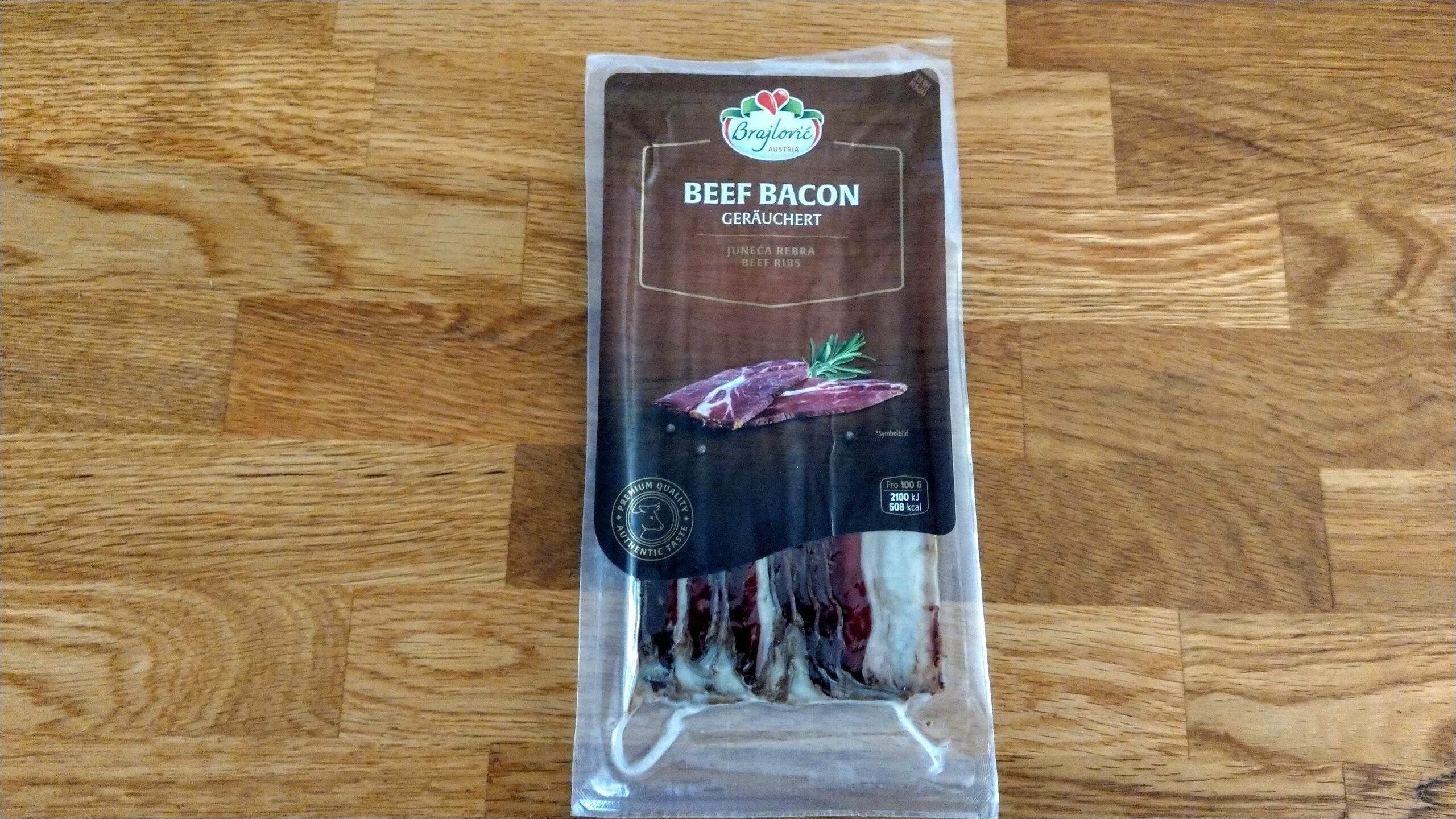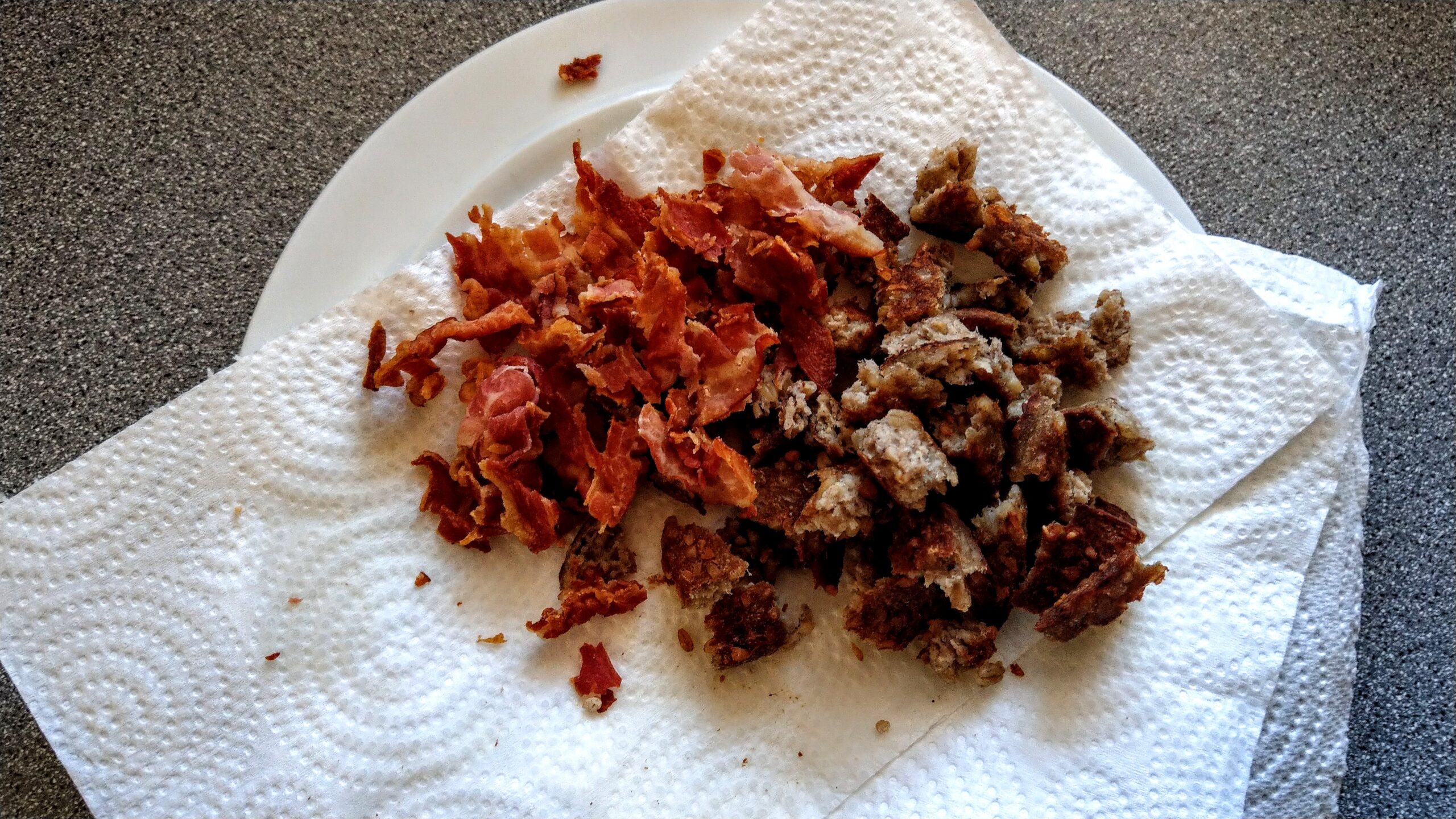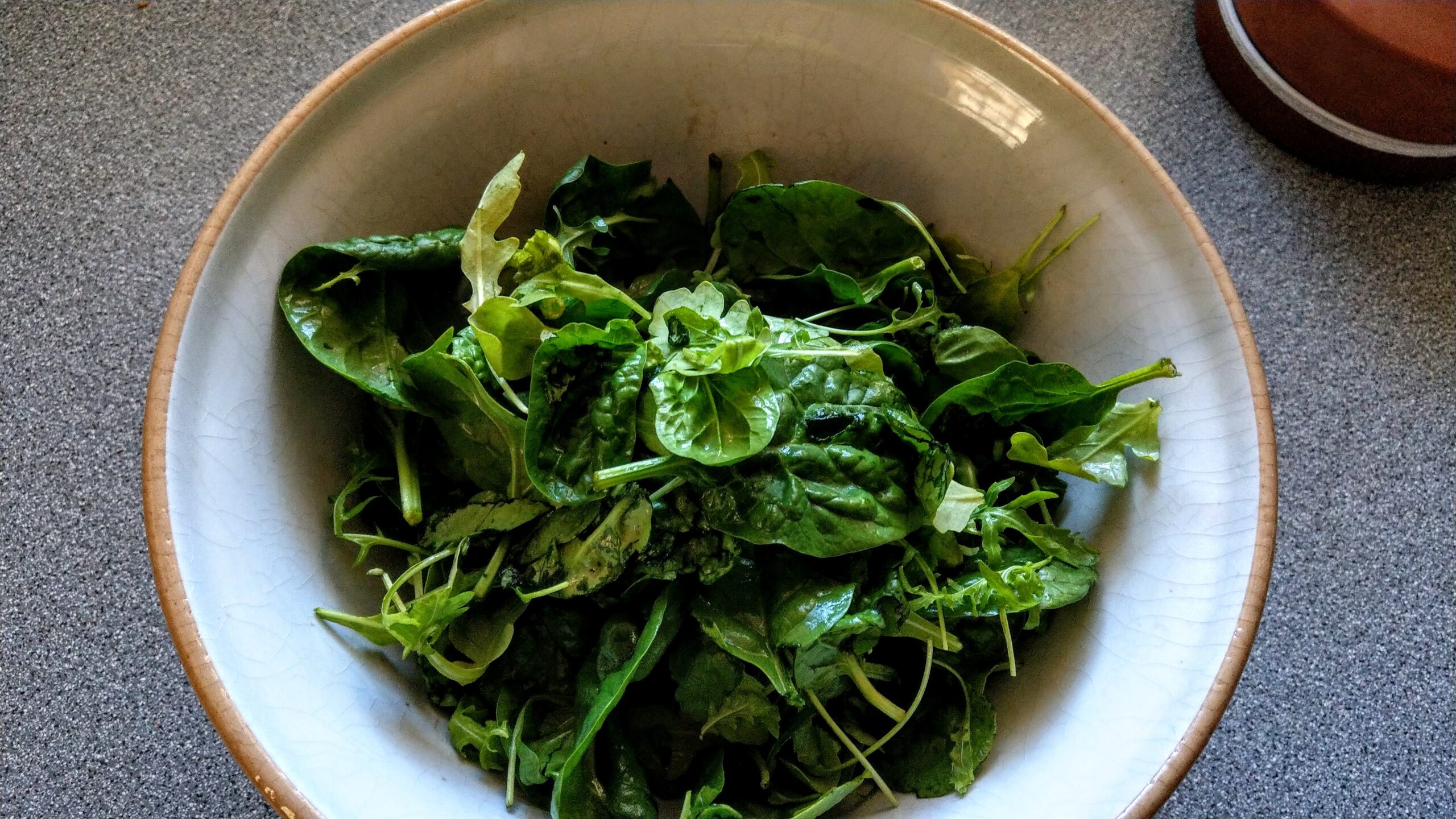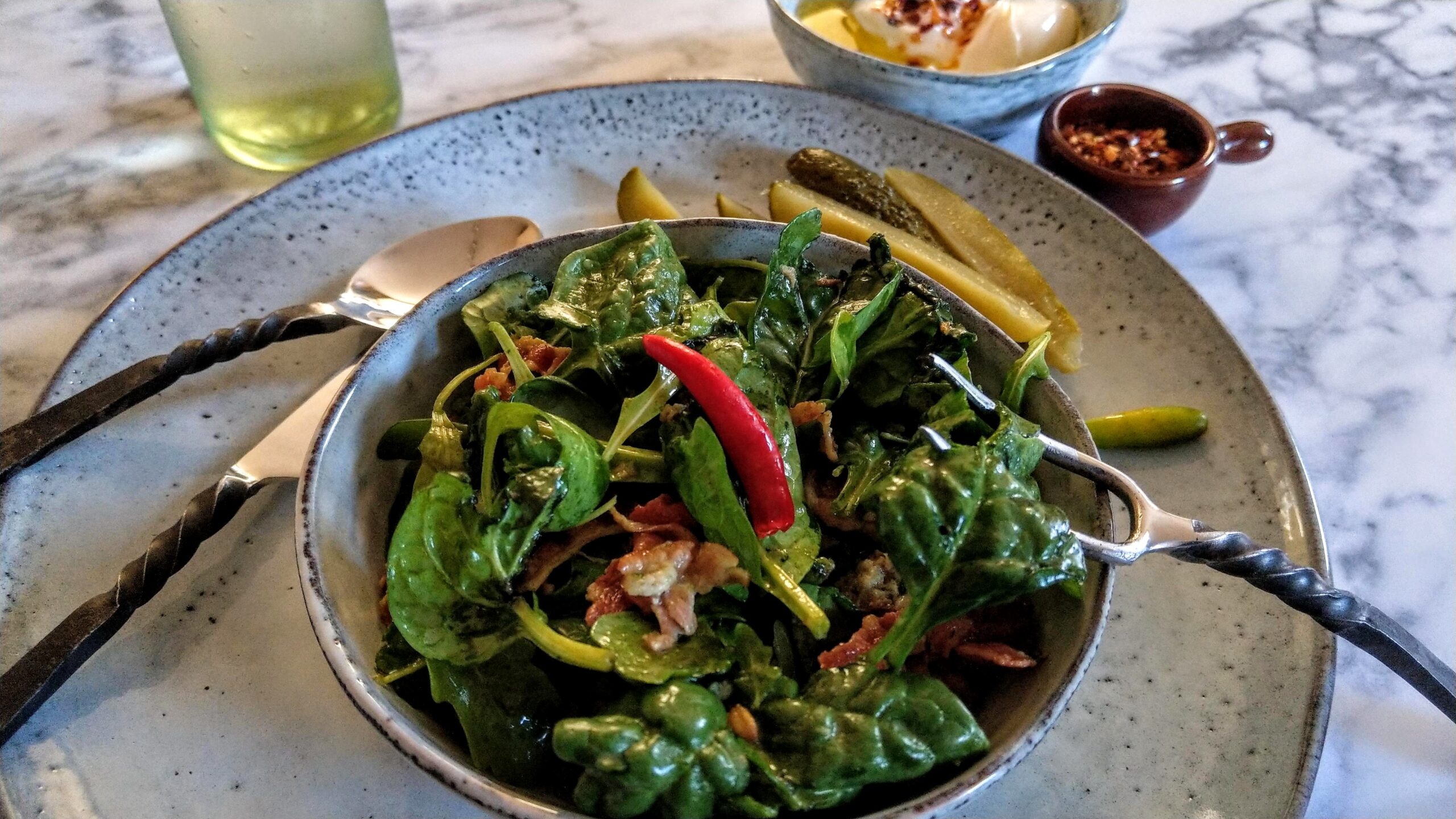Wilted Bitterleaf with Beef Bacon and Black Barley Sausage
An early-season salad with dark savory reminders of the autumn just past
- Background
- Recipe
With the exception of North Arlen—where the climate generally lies on the subtropical side of temperate—most parts of the Middle Kingdoms will have from the middle of the Winter season until the early-middle of Spring been experiencing a long, cold time during which fresh foods, and particularly fresh vegetables, are thin on the ground. As a result, salt meat or fish, dried pulses, and “clamped” long-storage root vegetables will for most people have dominated their dining tables during the hundred days of cold.
City dwellers, being fortunate enough to live in places with a higher than usual concentration of sorcerers and Rodmistresses, have a better chance of having access to magically-grown or -stored vegetables of all kinds, even during the cold months. But it takes a lot of energy (not to mention days or weeks off a practitioner’s lifespan) to raise and keep vegetables using sorcery or the blue Fire. As a result, produce sourced this way comes at a high cost. Both because of the price and the concept—and in some cases, a feeling of guilt at the thought of having such food when others can’t—a surprising number of people choose to forego magically-forced vegetables and instead wait for them to come into season.
So by the time the mid-Spring New Year’s holiday rolls around, in both the public-gardening areas associated with large cities of the Realms and in townland and backyard gardens in rural areas, just about everyone who can manage it has started some cultivation of fresh salad greens. All the Realms, even North Arlen, share the same term for this much-anticipated delicacy, though naturally the word proper differs between languages. Surprisingly, it’s a straightforward color term, not one originally meant for use on food (and still used when the vegetables in question aren’t actually green). Arl. and N.Arl. hnéwë, Dar. henéiu, Stl. enūht’w and Ladh. einhew-t all mean “[the new] shade”, specifically indicating the light vibrant color of that early tender new green of Spring, when the trees first leaf out. (Or in Ladhain usage, evoking the green of the earliest shoots of grass when, seemingly overnight, they burst through the soil of the overmountain plains).
Mostly the greenery indicated by this term when used in the culinary mode is destined to be eaten raw, though sometimes it winds up getting cooked as the season progresses. Many of the vegetables raised for this purpose have a bitter edge to their flavor, and are prized just for that reason—a stark and deeply-appreciated contrast to the too-common blandness of the previous season’s storage food. (They’re also valued for the “tonic” quality of the extra nutrients they supply, the bitterness correctly being seen as an indicator of their higher-than-usual and indeed borderline-therapeutic amounts of beneficial phytochemicals.*)
Another blanket term also pops up here. The originally Darthene word uintéshnë, “bitterleaf,” now means both the specific Middle Kingdoms variant of Cichorium endivia var. crispum—which we know variously as frisée, curly endive, or chicory—and a whole range of other greens, both mild and bitter-flavored, that are at their best when very young. This range includes vegetables that our Earth shares with theirs—for example, Brassica oleracea var. acephala, aka cavallo nero or Italian black cabbage, Brassica rapa var. ruvo, aka “broccoli rabe,” and Valerianella locusta, “lamb’s lettuce” or maché—and many that we don’t have, such as Steldene giant long cress (a distant relative of our Barbarea verna) and Seaboard bitter lancet (Brassica medioregna pilicula).
…Once the greens are grown and ready, of course, the question immediately arises: what to do with them? Entire cookbooks could easily be written on this subject (and in the Four Realms, have been). Everyone has their own favorite family or regional recipe. The approach we’ve chosen to share here is either Darthene- or Arlene-originated, depending on who you’re listening to. Leaving the contentious issue of its origin to one side, it’s a treatment that’s widespread in the southern and western regions where both beef and pork products are popular.
Here as usual with bitter-flavored greens, heat, salt and fat act in concert to tame the bitterness. The wilt-in-hot-fat method seems likely to perform well even against our world’s sharpest-flavored small salad greens, such as dandelion, mustard and the more peppery versions of aragula and escarole. But the version of this recipe we’re sharing uses baby spinach and rocket to allow the flavors of the beef bacon (a Darthene favorite) and the black barley sausage (an Arlene one) to move more into the foreground.
See the recipe in the upper right-hand tab.
*This level of knowledge might initially seem unusual in what otherwise looks like a group of cultures lying somewhere between the late Middle Ages and the early Renaissance. But when those cultures also contain magic-workers sufficiently expert to not only be able to directly perceive DNA structures, but rewrite them—as we see one character do in The Door Into Sunset—maybe this might come as less of a surprise. Medical and biological knowledge among Firebearers in particular is quite advanced and fairly widespread, as those who possess it and those who’ve had formal training know they have a mandate from the Goddess to share their expertise with those who haven’t had such advantages. For people who aren’t users of the blue Fire and just need the most useful part of the data, their local Rodmistress will simply say, “Eat your greens, they’re magic!” and leave it at that.
The ingredients:
Per serving:
- • 50-80g of bitter or very young greens of your preference (we used a mixture of baby spinach, lamb’s lettuce and rocket here, splitting the difference between bitter and mild)
- • 2-4 slices of a dark or light barley sausage (such as Irish/UK “black pudding” or “white pudding” (See below for a discussion of availability and alternatives)
- • 4-6 slices of beef bacon (though pork bacon will do just fine)
- • 2-3 tablespoons of oil to get the frying going (or if you have some handy, 2-3 tablespoons of lard)
- • Optional: a dash or two of vinegar or lemon juice to sharpen the dish when it’s ready to serve
- • Also optional: as a salad dressing, 2-3 tablespoons mayonnaise mixed with herbs or dried chili flakes
A few words about the ingredients before getting down to the recipe’s method:
Both the Darthene and Arlene versions of this dish are typical of the beef- and pork-rearing regions where they’re made, and in each case the versions of black (because of beef or pork blood) barley sausage with which they’re usually made reflect a strong regional preference. An our-Earth cook resident in a region that natively features such ingredients—as for example Ireland and the UK, with their various regional styles of black puddings, or Spain, for morcilla—won’t have trouble finding and substituting one of those. But cooks in other regions may have trouble locating a substitute, or may not like the blood involved due to either broader dietary preferences (i.e. vegetarianism) or just a dislike of the whole concept.
Some North American-based cooks who’re entirely happy with the concept or ingredients of European black puddings may simply not be able to get them, due to the US’s refusal to import them. In this case, the most useful suggestion may be to find a source that’s making them locally. One we’ve found that looks promising is Scottish Gourmet USA.
For UK-based cooks who’d prefer a vegetarian option, we suggest they take a look at the V Pud from The Real Lancashire Pudding Company or the vegetarian black pudding from the Bury Black Pudding Company. …There’s also a scratch recipe here for a vegan black pudding that looks like it might work.
…You may also prefer to say “Naah, all this is too much trouble…” and prefer to substitute a fried and crumbled patty of your local breakfast sausage meat, something along the lines of Jimmy Dean’s. This will work just fine.
Equally, you may have a hard time tracking down the beef bacon that’s routinely part of the dish in cattle-rearing regions of Darthen. (We’re lucky enough to be able to get ours [sometimes…] from a Croatian online grocery in Dublin.)

Here, too, you should feel free to substitute a normal pork bacon, as long as it’s one that cooks to crispiness and gives enough fat to wilt the greens at the end of the cooking process.
The method:
Fry your bacon first, and then, when its fat has run sufficiently, add the sausage of your preference.
If you’re using a beef bacon, as we did for this dish, be warned: it may smell quite strong when you first unpackage it. This somewhat-dubious aroma is apparently a side effect of the curing process, and quickly passes as it starts cooking.
Once the bacon is sizzling, add whatever extra cooking fat you may need — oil or lard, if that’s available — and add the sausage of your choice, reducing the heat a little so the bacon won’t burn while the sausage is frying.
When the sausage has been well cooked and has been turned at least once so as to acquire some crunch on both sides, remove the pan from heat and put the bacon and sausage slices on a paper towel to drain and dry a little.

Once they’ve drained, chop or crumble them.

Meanwhile, put your greens in a heatproof bowl.

Return the crumbled bacon and sausage to the frying pan and turn up the heat, so that the meats start to fry again. This is the time to add more fat if you think you’re not going to have enough to wilt the greens.
Then, just as the fat is starting to smoke, pour the whole business into the bowl with your greens, and toss everything very well until the leaves wilt in the hot fat.
Serve as quickly as you can, with seasonings on the side. Depending on the saltiness of the bacon you’re using, extra salt may not be required; but pepper and flaked dry chilies are usually a good touch, and in line with both the Arlene and Darthene takes on this dish.

Additionally, Arlene cooks often serve bitterleaf salads with an egg-and-oil-based dressing very similar to our mayonnaise (though usually based on strong-flavored oils like pumpkinseed) that has had pepper, allspice or more flaked chilies added to it. Our serving suggestion includes that.
Enjoy!
Vegetables, meat



